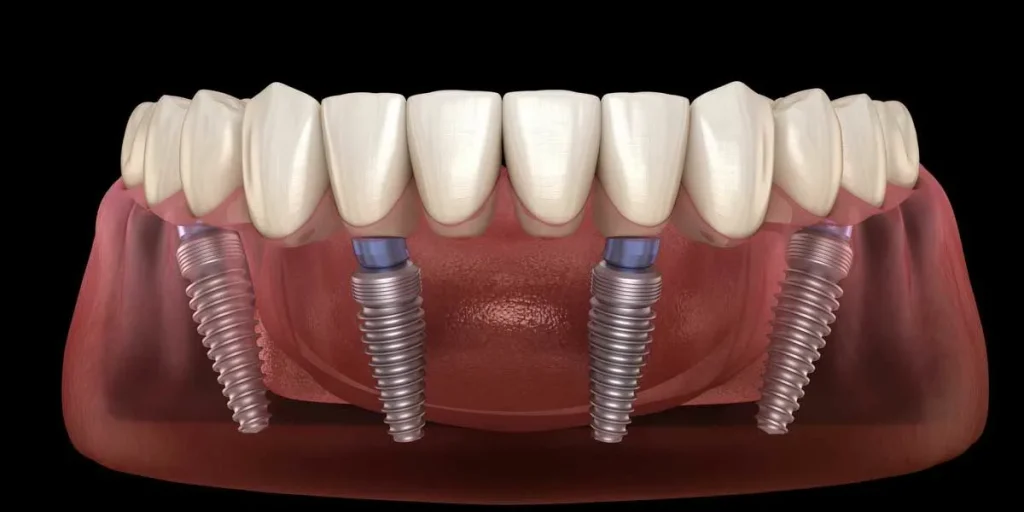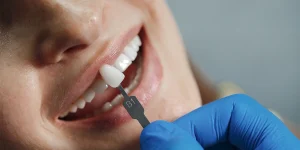When you consider multiple implants, you may wonder how many can be placed in a single session. The honest answer is that there is no fixed number.
Clinical reality depends on bone quality, medical history, the restoration you want, and the surgical plan.
This guide explains the typical scenarios, from replacing one tooth to multiple dental implants supporting full arch solutions like All-on-4, and the practical factors that determine how many implants can you have placed in a single visit. Understanding these limits is key to planning your permanent smile.
[toc]
What Decides How Many Implants You Can Get at Once
Several clear factors shape the answer for patients seeking multiple dental implants:
- Jawbone Density and Volume: Dense bone supports immediate placement and loading. If the bone is thin, you may require grafting first.
- Overall Health and Medications: Conditions like diabetes, smoking, and certain drugs affect healing and limit how much can be done safely in one session.
- Surgical Time and Anesthesia: Long procedures increase risk and slow recovery. Clinicians prioritize patient safety over excessive surgical time.
- Restoration Plan: A single crown has a different demand than an implant bridge or a full-arch prosthesis. Full-arch strategies intentionally use fewer implants per arch to support a fixed bridge. This dictates how many implants can you have.
- Imaging and Planning: CBCT scans, surgical guides, and digital planning allow surgeons to place multiple implants precisely and reduce operative complications.
What Are The Typical Scenarios and Practical Numbers for Multiple Implants
Below are common plans you will see in practice, detailing how many dental implants you can get based on the restoration needed.
- Single Tooth Replacement: One implant replaces one missing tooth. This is the simplest case and often completes in a single placement visit. The crown follows after bone integration.
- Multiple Adjacent Teeth or Implant-Supported Bridge: For a short span of missing teeth, two to four implants can anchor a bridge. This reduces the number of implants needed compared with replacing each tooth individually and often lowers the overall cost for dental implants for multiple teeth.
- Full-Arch Restoration and All-on-X Solutions: Full-arch options use four to six implants per arch in most modern protocols. All-on-4 commonly uses four strategically placed implants to support a fixed prosthesis. For full-mouth work, clinicians may stage arch treatments or place both arches in one surgical session when bone and health permit.
- Maximal Theoretical Limits: The guideline is not a set number, but rather, whether the treatment plan preserves healing and long-term success. The practical limit for how many implants can you have is determined by biology and patient tolerance, ensuring the viability of the multiple dental implants placed.
How Many Dental Implants Can You Get at Once?
Placing multiple dental implants in one session presents trade-offs that your surgeon will discuss.
Advantages
- Efficiency: You reduce the total number of visits and overall treatment time required.
- Cost Savings: Patients often save on chair fees and avoid the costs associated with multiple separate surgeries.
- Rapid Function: For full-arch cases (multiple implants), immediate provisional teeth can restore function and appearance quickly.
Drawbacks
- Intense Recovery: The single, longer surgery increases initial swelling and short-term discomfort.
- Complexity Risk: Complex cases requiring dental implants for multiple teeth may have a higher chance of needing bone grafts or staged healing.
- Post-Operative Load: Recovery can feel more intense due to the widespread nature of the treatment.
How Many Implants Can You Have Placed
A predictable workflow significantly lowers clinical risk when placing multiple dental implants.
Preparation and Planning
- Assessment: Thorough assessment, including CBCT planning, is critical. The surgeon precisely maps bone density, nerves, and sinus proximity to determine how many dental implants can you get.
- Surgical Guide: A surgical guide is fabricated. This ensures precise angulation and depth during placement.
The Placement Procedure
- Sedation: Implant placement occurs under local or IV sedation to ensure your comfort throughout the process.
- Implant Action: The surgical team carefully places the multiple implants, performs any necessary grafting, and meticulously records all lot numbers for future traceability.
- Initial Phase: The procedure concludes with either immediate placement of a provisional restoration or a crucial healing period of three to six months.
- Osseointegration: This healing time allows for osseointegration (bone fusion) before the final crowns or bridges are precisely fitted. Understanding this timeline is key to knowing how many dental implants can you get in total.
What is the Recovery Plan For Multiple Dental Implants
When you receive multiple implants, recovery requires careful adherence to post-surgical instructions to ensure successful integration.
Immediate Priorities (First Week)
- Rest and Diet: Rest is essential. Maintain a soft diet and avoid chewing near the surgical sites.
- Pain and Swelling: Use ice packs intermittently and take prescribed analgesics to control pain.
- Avoidances: Strictly avoid smoking and heavy alcohol consumption, as these significantly impede healing.
Follow-Up and Success
- Scheduled Visits: Keep all scheduled follow-up appointments. Clinicians monitor healing, check for any signs of infection, and decide when to load the implants.
- Long-Term Success: Good oral hygiene and timely professional maintenance greatly improve long-term success, regardless of how many dental implants can you get.
Frequently Asked Questions
Is It Safe to Get Multiple Implants at Once?
Yes, when performed by an experienced implantologist. Dubai clinics adhere to rigorous protocols, utilizing CBCT imaging and sterile surgical suites to minimize risk. Proper planning makes multi-implant placement both safe and predictable.
What Affects the Number of Dental Implants Multiple Teeth I Can Get?
Key determinants include jawbone density, your medical history, and the restoration type (single tooth, bridge, or full arch). Your implant dentist assesses bone volume and overall health before determining how many implants can you have done in one visit.
Mapping the Safest Plan For Your Dental Implants
So, how many dental implants can you get at once? The safe number depends entirely on your bone quality, health, and final restoration. From single implants to multiple implants and full-arch solutions like All-on-4, modern imaging allows for efficient care.
If you are weighing dental implantsfor multiple teeth, book a consultation. Have a CBCT taken so your surgeon can tell you precisely how many implants can you have placed safely in one session.




